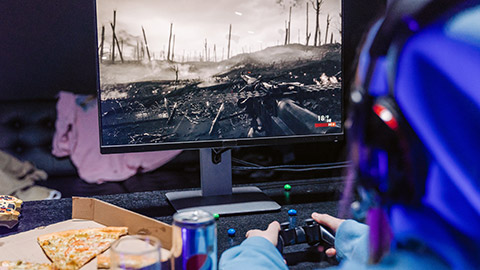Game design isn’t just a technological craft. It’s a twenty-first-century way of thinking and leading.Jane McGonigal
In the dynamic realm of eSports, the role of game design stands as a linchpin, dictating the success and resonance of digital experiences. Game design isn't merely about creating visually appealing interfaces or entertaining gameplay; it's an artful fusion of psychology, technology, and storytelling that holds power to captivate audiences, nurture engagement, and steer strategic objectives. Let us look into the pivotal significance of game design.
There is no secret recipe for videogame creation, but there might be a frame of action to create something that is recognised as well-made.
Creating a good video game is hard to master. Have you ever wondered what games a video game transcends to become good or amazing? Let's navigate through the basics of video game creation, the resources you need, and the challenges you may face while trying. Here is a list of the things we need to be aware of in video game design
Concept
To create something, there must be intent, an intention to create, and video games are no exception. Thought must be put into the concept behind the design.
At this point of conception, we must review all the different aspects of the game itself, its challenges, its appeal to the users, its practicality, etc. Some of the things we need to review include (but are not limited to) genre, platform, game modality.
View

View is how the user/player observes the game. All though it may depend on the engine the game was created. Depending on the engine, the game would be able to give different perspectives to the user.
First person view
First person perspective is the vantage point through the character's eyes. This is why, most of the time, players can not see the avatar's body. Even though they are not aware of their looks, players may be able to get a glimpse of its clothing, gear or weaponry.
This perspective limits the player's field of vision to what the character would realistically see, and it creates a sense of being "inside" the game environment. Players can interact with the world using the character's hands or tools as extensions of their own.
Second person view
In the context of game design and perspectives, the second-person view is a relatively uncommon concept and is not frequently used in video games.
In narrative writing, the second-person point of view addresses the reader directly, using pronouns like "you" to immerse the reader in the story. In the context of video games, a true second-person perspective would involve the player directly controlling a character that is not their avatar, creating a sort of interactive spectator experience.
Third person view
The third-person view refers to a camera perspective in which the player views the game world from a position external to the character they are controlling. Instead of seeing through the character's eyes (first-person) or directly controlling a character (second-person), the player observes the character from behind or above, often with the ability to freely manipulate the camera angle to get a better view of the environment.
Players can see their character's actions, movements, and interactions with the game world. This perspective provides a broader and more cinematic view, allowing players to see their character's appearance and actions in relation to the surrounding environment. It's commonly used in various video game genres, including action-adventure, role-playing, platformers, and more.
The following video provides a quick overview of the first, second and their perspectives on gaming.
Watch: First vs. Second vs. Third-person Perspectives in Video Games (1:11 minutes)

Game design is the architect's blueprint that constructs immersive worlds and enthralling narratives, fostering deep connections between players and their digital environment. In eSports, the meticulous arrangement of game elements influences competition dynamics, player strategies, and spectator engagement. Take "League of Legends," where strategic balance between characters' abilities shapes intense battles, drawing in players and viewers alike. In business, game design principles have been harnessed to craft engaging apps, like Starbucks' loyalty program app, which employs game-like rewards and progress tracking to enhance customer retention.
Design Principles
Let’s look at the design principles to consider in game design.
User-Centric Experience
Every aspect of game design revolves around the player or user. Just as in business, where customer needs dictate product development, game design prioritizes user experience. "Fortnite" has masterfully integrated this principle, consistently updating its content to meet player demands, leading to unprecedented player engagement.
Feedback Loops
Games thrive on instant feedback, providing players with a sense of accomplishment and progress. This principle transcends to business environments. For instance, fitness apps like "Strava" offer real-time performance data, driving users to improve and stay engaged, mirroring how feedback loops encourage employees to enhance their performance.
Narrative Engagement
A compelling storyline forms the backbone of game design, captivating players and propelling them through challenges. Businesses can adopt this by weaving narratives into their products. The "Assassin's Creed" series illustrates this principle, blending historical fiction with interactive gameplay, a model businesses like Airbnb have emulated through travel experiences with immersive storytelling.
Balanced Challenges
Games balance difficulty and reward, ensuring players are engaged without feeling overwhelmed. This principle has its parallel in business, where projects should be challenging enough to stimulate growth without causing burnout. The mobile game "Angry Birds" exemplifies this by progressively introducing new challenges, sustaining player interest over time.
Knowledge Check Activity
Game genres play a crucial role in the world of emerging technologies, eSports. They determine the gameplay mechanics, target audience, and overall experience of a game video game genres are not “sci-fi” or “historic”. Video game genres are based around the game mechanics. The mixture of game genre, game mechanics and world environment is a backbone of your next video game.
Examples of game genres
The following are some examples of various game genres.
- Flipcard 1: https://overwatch.fandom.com/wiki/Overwatch_(group)
- Flipcard 2: https://www.zonafree2play.com/2018/02/proximamente-2-grandes-actualizaciones.html
- Flipcard 3: https://www.gameblast.com.br/2015/06/witcher-3-atualizacao.html
- Flipcard 4: https://pc-gaming.it/legend-zelda-breath-wild-60-fps-emulatore-cemu/
- Flipcard 5: https://androidpctv.com/fortnite-performance-mode/
These genres represent just a fraction of the diverse gaming landscape, and they continue to evolve as emerging technologies and digital tools enhance gameplay mechanics and experiences. In the world of eSports and business development, understanding these genres can help developers, marketers, and organisations tap into the preferences of gamers and enthusiasts.
Game mechanics are the foundational rules, interactions, and systems that define how a game operates and engages its players. These mechanics create the framework for player actions, motivations, challenges, and rewards, shaping the overall experience. In the realm of emerging technologies, game mechanics are being harnessed not only for entertainment in eSports but also for innovative business development strategies.
For example, in "League of Legends," players progress by earning experience points, unlocking new champions, and climbing ranked leaderboards. While "Fortnite" uses challenges to encourage players to complete tasks like finding hidden items, rewarding them with in-game currency and unique character skins.

Various programming languages can be used to implement game mechanics in eSports, depending on the game engine and platform you're working with. Here are a few examples of programming languages commonly used for implementing game mechanics:
C#
C# is commonly used with the Unity game engine, which is popular for both game development and creating eSports experiences. C# can be used to implement various game mechanics, including user interface interactions, animations, and event handling. For instance, in an eSports strategy game, C# could manage unit movement and combat mechanics.
Python
Python is known for its ease of use and is often used for scripting and rapid prototyping in game development. While it might not be the primary language for high-performance gameplay mechanics, Python can handle the logic for various non-performance-critical aspects. In an eSports game, Python could be used for scripting NPC behaviour or managing in-game events.
JavaScript
JavaScript is primarily used for web-based games and interactive experiences. With the rise of web technologies and browser-based eSports games, JavaScript can handle front-end interactions, user interfaces, and real-time player communication. The choice of a programming language often depends on factors like the game engine, the specific mechanics you're implementing, and your team's expertise. Regardless of the language, a solid understanding of game design principles and mechanics is crucial to creating engaging eSports and gaming experiences.
Each game played has a carefully designed world or environment suited to the genre. Some games may have been designed to convey a battlefield, while some convey a castle.
The Environment
Geography
What is the surrounding environment? Sea, acid rain clouds, large mountains, concrete jungle (city), ice jungle. For a small-scale game, 1 geographical location is fine. For a larger game creating multiple geographical locations is necessary.
Climate
The temperature of the environment, how do the seasons affect the environment? Is it natural or man-made etc?
Resources
What types of resources surround the area? Resources include wood type, metal type, food type, and water type. Geography and climate will directly affect the types of resources available.
Architecture
Buildings, houses, meeting houses etc. Describe the material, height, use of the buildings etc.
Transport and Infrastructure
How does the population travel through the environment? Again, the resources, climate, and geographical location should directly affect travel.
|
Geography Deserted sand dune. The land is surrounded by beautiful deep golden sand. Flat land mixed with dunes (hills) |
Climate During the day temperatures can reach up to a 70° Celsius. During the night temperatures can reach -20° Celsius. With the extreme temperature change, the dunes are a harsh environment to live in. |
|
Resources The sand dunes are full of grains of quartz. Below the dunes are crystallised quartz. This quartz is more powerful than common quartz found on Earth. |
Architecture Abandoned industrial buildings made from exported products brought over from other planets. Concrete (stone). These show signs of a past civilisation. There is also signs of advanced technology with natural quartz. |
|
Transport and Infrastructure Land speeder type vehicles stimulates the effect of flight powered by the natural quartz. This allows the population to travel across the dune effectively and quickly. The population tend to walk with moon boots which allows them to walk on the sand. |
|
The Inhabitants
Inhabitants
Who are the inhabitants? Robots, humans, aliens, 7ft warriors, telekinesis powered rocks?
Social Structure
What type of social structure is there? (Rich/Poor, High/Middle/Slaves) or no social structure.
Politics
What type of politics run the inhabitants? EG democracy, authoritarianism, totalitarian, monarchy etc.
Religion
How many types of religion is there? Is it one religion that rules the land or multiple religions?
Education
What type of education is provided? Only the wealthy are educated or is all fair across the land.
Industries
What types of jobs are available? Fishing, farming, field workers, chefs, servants, educators, vehicle engineers etc.
The Culture
Culture is expansive. This includes many factors such as art, food, fashion, language, social habits, holidays, festivals etc.
The following video illustrates fantasy worlds in gaming.
Watch: Top 10 Best Fantasy Worlds In Gaming (14:16)
Design a game- character or environment
The immersion of a video game comes down to the environment and character/s. A rich world full of colourful and fantastic characters helps the players feel like they are in the world.
Take for example, ‘Red Dead Redemption’ a western action-adventure set in the late 19th century United States of America (fictionised).
To build immersion for the audience the developers would have had to go through countless hours of research on the types of trees and leaves, common terrain, slang and language, horse breeds, wood type, food and beverages etc. All of this is to build a world environment that can be portrayed as a believable United States.
The same goes for all the characters, from their names to the aesthetics of their clothing, scars, and even their voices. This is the kind of thought that should go into creating a game with strong immersion.
The following video delves into factors that influence game design, including environments, characters and systems.
Watch: From imagination to reality: Designing captivating game worlds (14:11 minutes)
Knowledge Check Activity
